Week in Wrestling: Scott Hall says WWE should welcome back Hulk Hogan

SI.com’s Week in Wrestling is published every Wednesday and provides beneath the surface coverage of the business of pro wrestling. This issue opens with an interview with Scott Hall, The Nitro Files with Eric Bischoff discussing the 1997 Halloween Havoc, The Shoot from Jesse “The Body” Ventura, as well as Five Questions with NXT’s Big Damo.
Hello from “The Bad Guy” Scott Hall
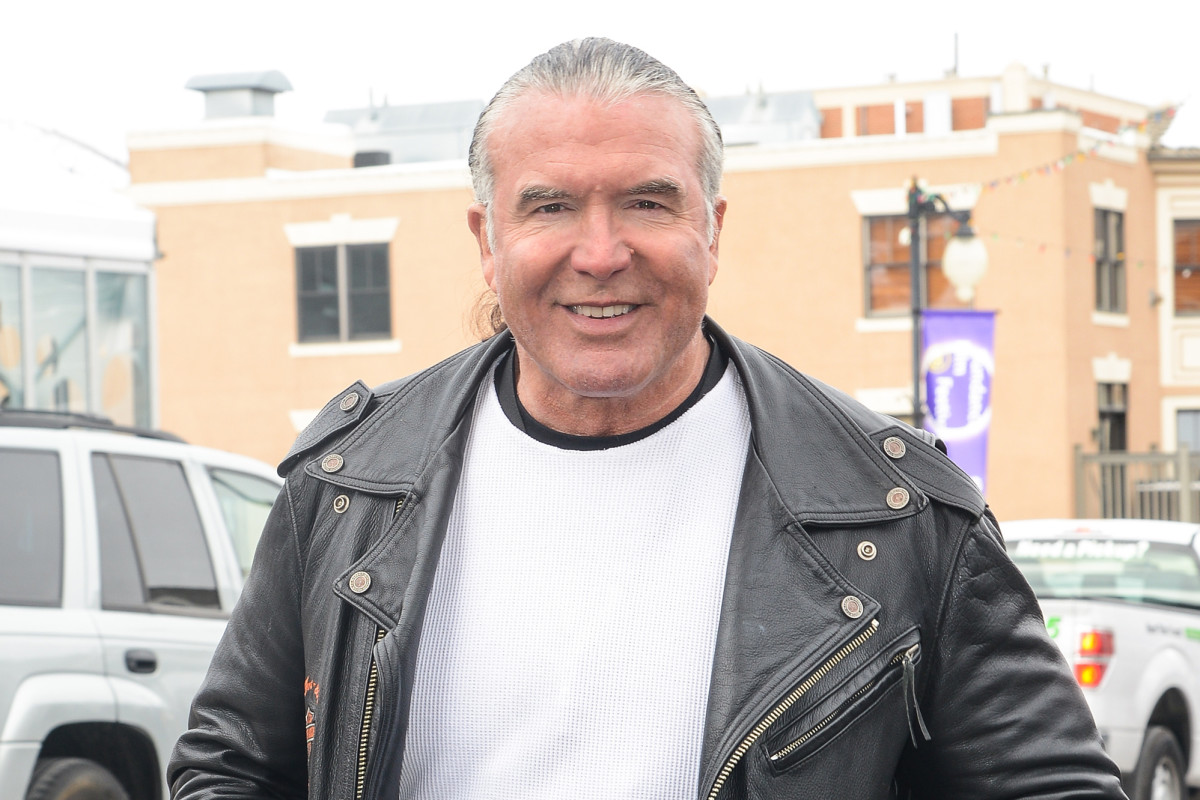
It’s been a little more than a year since Hulk Hogan was fired by WWE for the racist comments he made on a 2007 sex tape, but Scott Hall is adamant that Hogan will and should return to WWE.
“Yes, Hulk will be back,” said Hall. “After a thirty-three year relationship with the WWE, he had a bad day—and that bad day was nearly ten years ago. That sex tape happened during a brutal time in his life. He was going through a divorce, his son Nick was in a car crash, paralyzed his buddy, and was facing jail time. His daughter was starting her hip-hop career, and Hulk was backing that, paying money out of his own pocket for that. The whole world was coming down on him, and he slipped up. He said the wrong thing. I’ve been around Hulk a lot and never seen that side of him. I’ve only seen a kind, generous guy. If the door is not open for him, it should be.”
Hogan remained in the discussion when Hall harkened back to WCW’s World War 3 pay per view from November of 1997. Hall won the 60-man World War 3 match, which—allegedly—assured him a future title shot with the WCW champion.
“I won at World War 3, and I was supposed to get the title shot at SuperBrawl,” explained Hall. “That was traditionally a big draw for WCW, and I was supposed to be the main event there vs. Sting. But Hulk c---blocked that and he took the main event spot and I never got the title match. That’s WCW in a nutshell.”
Hulk Hogan: WWE fired me in the middle of the night
Hall looks good, sounds even better, and is currently keeping busy by working assorted independent shows across the country. He always had a sharp mind for the business, and he offered his take on the progress of United States champion Roman Reigns.
“I would have kept pushing the guy,” said Hall. “I didn’t like what they did when he put Finn Bálor over on Raw and they humbled him after the match. He had to do an interview in the aisle after he lost and put Bálor over again. But that was on the heels of something happening with him and the Wellness Program. There is only one place to work now, so things have tightened up. If you don’t like it, what are you going to do? So Vince is cracking the whip, and everybody’s got to get in line. When I was there, they drug tested. Sometimes, in a ten-day loop, we’d have four drug tests. They cracked the whip then too, and everybody got in line. If you want to work in the United States, there is only one place to work—and that is WWE. If they’re running a tight ship, then get in line.”
Hall recently suffered a relapse with alcohol, and explained that every day is a battle to remain clean and sober.
“I’m not where I want to be, but I thank God I’m not where I used to be,” said Hall. “It’s a slippery slope. I’ve fallen in the past, and I may fall again in the future, but I get up now. There were times in the past when I’d fall and I’d just stay there. Now, when I fall, I get up.”
Hall also addressed the question of whether Seth Rollins is dangerous in the ring. Rollins has dealt with allegations of recklessness after he broke John Cena’ nose, severely injured Sting’s neck, and tore Finn Bálor’s right shoulder during matches.
“No, Seth is not dangerous,” countered Hall. “Certainly Seth was never intending to hurt anybody, and you’ve got to remember that Sting hadn’t wrestled much in the past five years and he was in his fifties. It’s really becoming en vogue for a lot of these new guys to do moves on the apron. That’s becoming really trendy, and that’s where the ring is really hard. Powerbombing someone on the apron or into the turnbuckle, those are not moves Sting and I grew up with. He wasn’t really conditioned to take it, he hadn’t practiced it, and I think he whiplashed his 56-year-old neck. It’s a shame to see a guy of that caliber go out with an injury, but he had a great run. But no, Seth is not reckless.”
The Bálor injury was especially devastating, Hall admitted, because he is enamored with the former NXT champion.
“The guys who I currently follow start with Finn Bálor,” said Hall. “I’m such a fan of his, and I was so sorry to see him get hurt right at the zenith of his push.”
Hall’s list of favorites also includes Kevin Owens and Shinsuke Nakamura.
“I’m also a big Kevin Owens fan, and Shinsuke Nakamura is over like a rock star,” said Hall. “People want him pulled up right away, but at the same time, they’ve got to keep NXT alive. NXT is working better than anticipated. When guys leave NXT and go to the main roster, those guys are already over. Before, a lot of guys languished in FCW and OVW. Now that Triple H is running it from head to toe, it’s the hottest show out there—so everything is going better than planned.”
On a more personal level, Hall’s son, Cody, has returned after reportedly suffering a head injury this past April while working with New Japan.
“Cody is back to Japan,” reported Hall. “He’s back at the dojo, ready to go. He’s not looking back, just looking forward.
“Once you learn how to work inside the ring—once you learn how to tell a story—then you can come to a big company like the WWE and learn the extra stuff, like the video, the pyro, the music, and that adds to everything you can do. But it all comes down to how you work in the ring, so Cody is focused on learning the basics over there. It’s all about what you do when you hit the curtain, when you walk the aisle and when you step through the ropes. All the extra stuff is just gravy added to it.”
As for the next step in the life of Scott Hall, his dream job remains working as a trainer with NXT.
“In a perfect world, I’d end up at NXT,” revealed Hall. “I also realize that getting clean is one thing, but staying clean is another. I need to stay clean for a long time. The best thing I can do is keep showing up places with a clear head and see what happens.”
And, for those wondering, Hall is very impressed by The New Day’s 437-day tag team title run, though he claims that the “Power of Positivity” would stand no match for The Outsiders.
“That match would have been a lot of fun,” said Hall. “It would have been great, and Xavier Woods—he’s the fall guy, right?—would have taken the Razor’s Edge.”
News of the Week
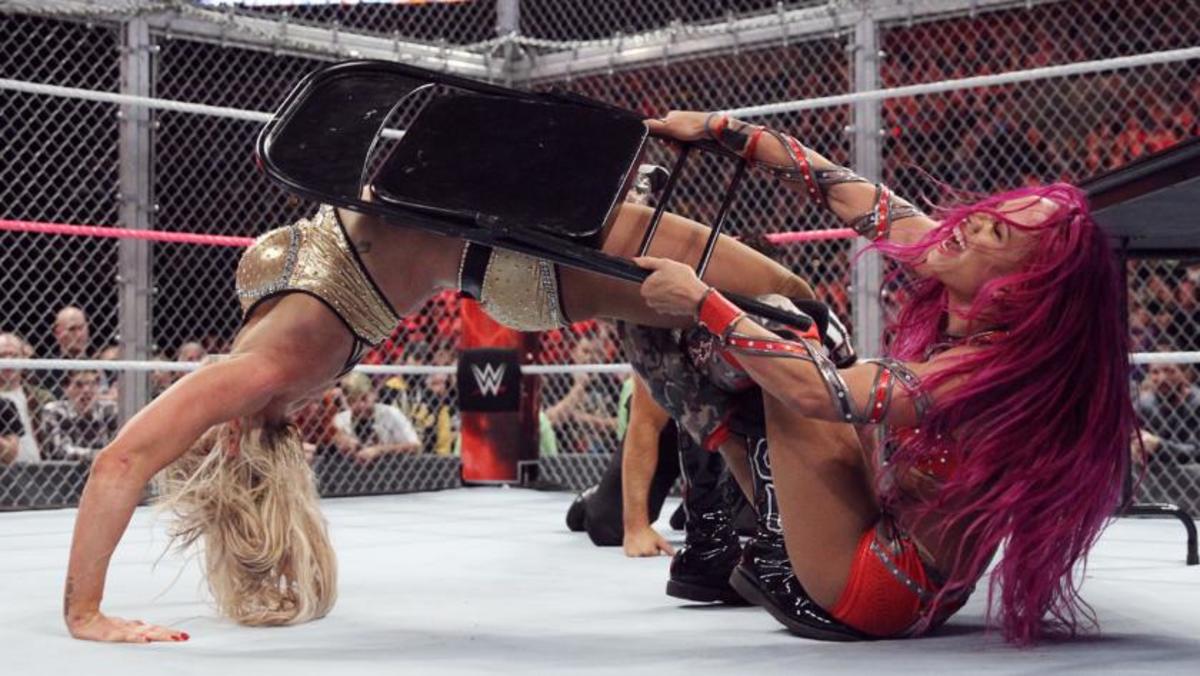
Imagine if the Royal Rumble pay per view had three different battle royals? Inevitably, each battle royal would mean a little less. Over time, the lack of meaning would multiple.
The Royal Rumble is special, in part, because it has a legitimate stake as the winner goes onto headline WrestleMania, but this past Sunday’s Hell in a Cell pay per view held no such significance.
The night featured three matches in the cell, beginning when Roman Reigns and Rusev opened the show to a white-hot crowd in Boston. I loved the spot where Rusev had Reigns in the chained Accolade, until Reigns used his superhuman strength to break. The move begged the question: why does WWE book Reigns to win matches in such an unbelievable fashion?
Seth Rollins and Kevin Owens had the match of the night with the spot of the night in the table powerbomb.
#WWE #HIAC pic.twitter.com/JTaeqFave6
— Justin Barrasso (@JustinBarrasso) October 31, 2016
The historic women’s main event between Sasha Banks and Charlotte saw an anticlimactic finish—when a table refused to break—that sucked the life out of the crowd, but the match was actually pretty solid. I fail to understand the logic of having Banks defeat Charlotte for the women’s title on Raw on two separate occasions only to drop it back at the ensuing pay per view. At this pace, Charlotte will be a 16-time champ before John Cena.
The topic of discussion entering Hell in a Cell was whether the women should main-event, but the real point of contention is whether WWE should have multiple Hell in a Cell matches.
One major Hell in a Cell match keeps the concept fresh and enhances its meaning. Otherwise, we end up like we did on Sunday—with compelling matches, but ones that did not conclude any of the storylines in a meaningful fashion in what should be the most memorable encounter of the year.
In other news…
• The Raw vs. Smackdown nature has added an entirely new element of excitement to this year’s Survivor Series. Whether it is the main event spot for the brand at WrestleMania, or the final spot in the Royal Rumble, the winner of the five-on-five match should mean something for viewers to become even more invested in the outcome.
• The TLC pay per view for Smackdown comes on the heels of Survivor Series on Dec. 4 and will be headlined by AJ Styles defending the WWE championship against Dean Ambrose in a TLC match, Shane McMahon announced last night on “Talking Smack.”
• Styles has now spent 53 days as WWE champion. That number has already surpassed Mick Foley’s three reigns that totaled 47 days as WWE champ, and Styles is now only two weeks away from passing Daniel Bryan’s total of 65 days as champ during his three title reigns.
• This is not the first time I have made this point, but it bears repeating: Luke Gallows and Karl Anderson would be a far better fit on Smackdown. The former IWGP champions looked impressive in a much-needed victory at Hell in a Cell until Gallows dealt with a comedy defeat in a Halloween, pumpkin-themed match with Enzo Amore on Raw. A brand swap of the Uso’s and Gallows/Anderson would help both teams.
• Grounded, technical affairs are not what people envisioned for the cruisers. That is not a knock on WWE’s cruiserweights, but the problem within the division deals directly with identity. How are the cruiserweight matches, besides the size of the competitors, any different than the rest of the card on Raw? Eric Bischoff successfully used his cruisers, in his own words, as a “human car crash”—and people enjoyed seeing matches that were so far different than what we normally saw on television. The cruisers, unfortunately, have yet to tap into that formula and, so far, are far too similar to the rest of the card.
• Colt Cabana’s Wrestling Road Diaries 3: Funny Equals Money, which he discussed two weeks ago in a very meaningful edition of The Shoot, is now available for pre-order on DVD and digital download. Autographed covers are included with the purchase of the DVD, and the digital version is available to download starting on November 11. “Comedy in wrestling is something that I'm very passionate about,” Cabana shared with SI.com. “It’s also something that’s never really been explored in depth like this. To be able to bring over Kikutaro from Japan and Grado from Scotland and record this docu-series, it makes me so proud. I’m even happier that the movie turned out so great!”
• I spent Saturday night at the XWA show in West Warwick, Rhode Island, and the highlight of a great night was the main event between Zack Sabre Jr. and “Pro Wrestling Savior” JT Dunn. The two fought to a 25-minute draw, and will have a rematch—this time including Ricochet—at the next show in November.
• Jesse “The Body” Ventura, who wrote this week’s The Shoot, last appeared on WWE programming seven years ago in November of 2009 when he served as guest host of Raw. My favorite part of the show was when he and Vince McMahon reunited to do commentary for the 8-man breakthrough battle royal.
• Austin Aries showed off his gruesome eye injury, which was courtesy of a Shinsuke Nakamura kick. Aries is pursuing Nakamura’s NXT championship. If he or Bobby Roode are able to dethrone Nakamura and become champ, then two out of the last three NXT champions will be former TNA heavyweight champs.
• Coming attractions: Sports Illustrated will run a “Hardcore Flashbacks” piece with Raven and the Sandman next Monday on SI.com.
The Nitro Files: Halloween Havoc 1997
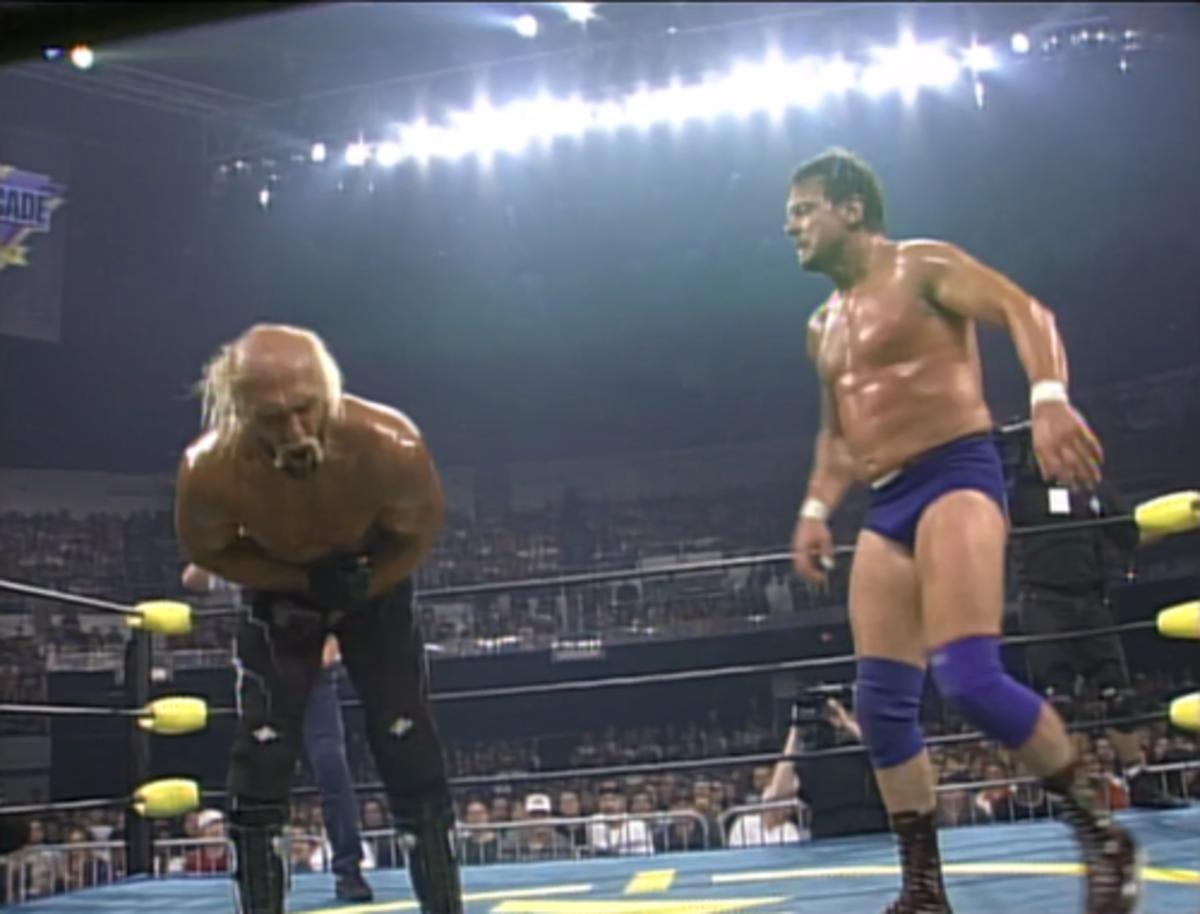
The Nitro Files with Eric Bischoff will delve into a moment from WCW’s Nitro era. Bischoff, who was the WCW’s president during the company’s most successful years, hosts his weekly “Bischoff on Wrestling” podcast, as well as delivers a “Controversial Video of the Week” with 120 Sports’ Nick Hausman, and plans on proving every week in the Nitro Files that the “truth is out there.”
The 1997 Halloween Havoc just celebrated its nineteenth anniversary, and looking back at the outrageous roster of talent competing for WCW, running the company was no easy task.
Guaranteed contracts and demands from superstars added to the everyday stress of Eric Bischoff’s day-to-day operations, which also included battling Vince McMahon’s World Wrestling Federation.
“Talent had a certain amount of leverage,” said Bischoff. “The talent also knew—and always does, and this goes for the wrestling, music, and any other industry where there is an artist—there is always an alternative. While you may be the biggest star at the moment, you’re also aware that there may be another star coming up right behind you, which fuels that paranoia that exists in the negotiation process.”
The top-eight wrestlers on the card consisted of Hulk Hogan, Roddy Piper, Randy Savage, Ric Flair, Curt Hennig, Scott Hall, Dallas Page, and Lex Luger—not to mention Kevin Nash and Sting—with an undercard featuring the likes of Chris Jericho, Eddie Guerero, and Rey Mysterio.
“It was a lot of personalities to keep happy, but it was also a lot of creative input,” explained Bischoff. “All of those names had really great experience and understood their character really well, so it was as much of a creative challenge as it was a study of human nature. You really had to make all of those creative instincts fit together, and that was one of the things that aged me more than anything else.”
Bischoff had just wrapped up a tense series of contract negotiations with the “Macho Man” Randy Savage right before Halloween Havoc on October 26, 1997. Savage went on to defeat “Diamond” Dallas Page later that evening in a “Las Vegas Sudden Death Match,” but viewers were unaware that he had been locked away in a hotel room with Bischoff that morning.
“That was the Sunday morning of Halloween Havoc, and Randy’s contract was up for renewal,” recalled Bischoff. “His contract was coming up and we were close enough where we were into serious re-negotiations and discussions, and he was an intense, unique individual—who I miss greatly and loved working with—but he was his own unique animal. When he gave me a call and said, ‘Brother, come on down, we need to talk about my deal,’ I knew it was because Randy was planning ahead. He wanted to know what his options were, and he wanted to understand his leverage—which is why he wanted me in his room at 8 a.m. after I’d been out partying all night in Vegas. It was a smart move, because I was beat to death.
“It was typical Randy. I walked in the room and he was standing in a towel, and I walked into the suite. We were talking while I was in the suite and Randy was in the bathroom, discussing the kind of superfluous stuff that precedes a negotiation, and someone came to the door. It was room service, and I opened the door and the waiter walked in—and Randy was stark ass naked behind us with black hair dye in his hand. The waiter immediately looked over to Randy in shock, then the waiter looked at me, and all I said was, ‘Oh my gosh, I can just see the headline tomorrow.’ Thankfully, that was before TMZ.”
The main event for Halloween Havoc was a brilliantly crafted match between the two main tenets of the original WrestleMania: Hogan and “Rowdy” Roddy Piper.
“Hogan and Piper—and guys like Savage, Ultimate Warrior, and so many others—had lived through the old school wrestling mentality of protecting their gimmicks and protecting their spot,” said Bischoff. “By the time I started working with them, and I’m not going to suggest that no longer still existed, because it did – but Hulk and Roddy, for example, were gracious and generous with each other. The conversations leading up to Halloween Havoc in 1997 were far more about how to put each other over than how to get themselves over.”
Piper defeated Hogan with a sleeper hold, and the crowd in Vegas at the MGM Grand Garden Arena soaked up the finish. While Hogan developed a reputation for looking out for himself, Bischoff explained that viewpoint was far from accurate, and that Hogan’s main priority was looking for the direction of the story.
“Hulk was not selfish,” said Bischoff. “In my experience working with Hulk, I never had that problem with him. The challenge with Hulk—and this is the one thing people don’t know unless they were in the trenches—is you could get layout ideas for a match, moments or high spots, and that’s easy to do. But it’s really difficult to come up with a great story. I’d lay something out in front of Hulk, and he’d stroke his fu-manchu, and then the first question out of his mouth was, ‘Where’s it going?’ That would stop most people in their tracks – most people are only thinking about that moment, that high spot, or the finish. They don’t think about where it goes, progresses, or how it lives.
“If you do it right, you’re creating a story and something bigger than a fifteen second finish in a pay per view. I learned a lot from Hulk, and I still hear him asking, ‘Where is it going?’ If you could tell him, then he was in. But if he asked that question and you said you didn’t know, or you gave him a BS answer, then he’d tap out. That was his instinct as someone who understood the business. Unless you have an arch, unless you have a story that is going somewhere, then it is nothing more than a brief moment in time that people will forget about in two weeks.”
The Shoot: Jesse “The Body” Ventura
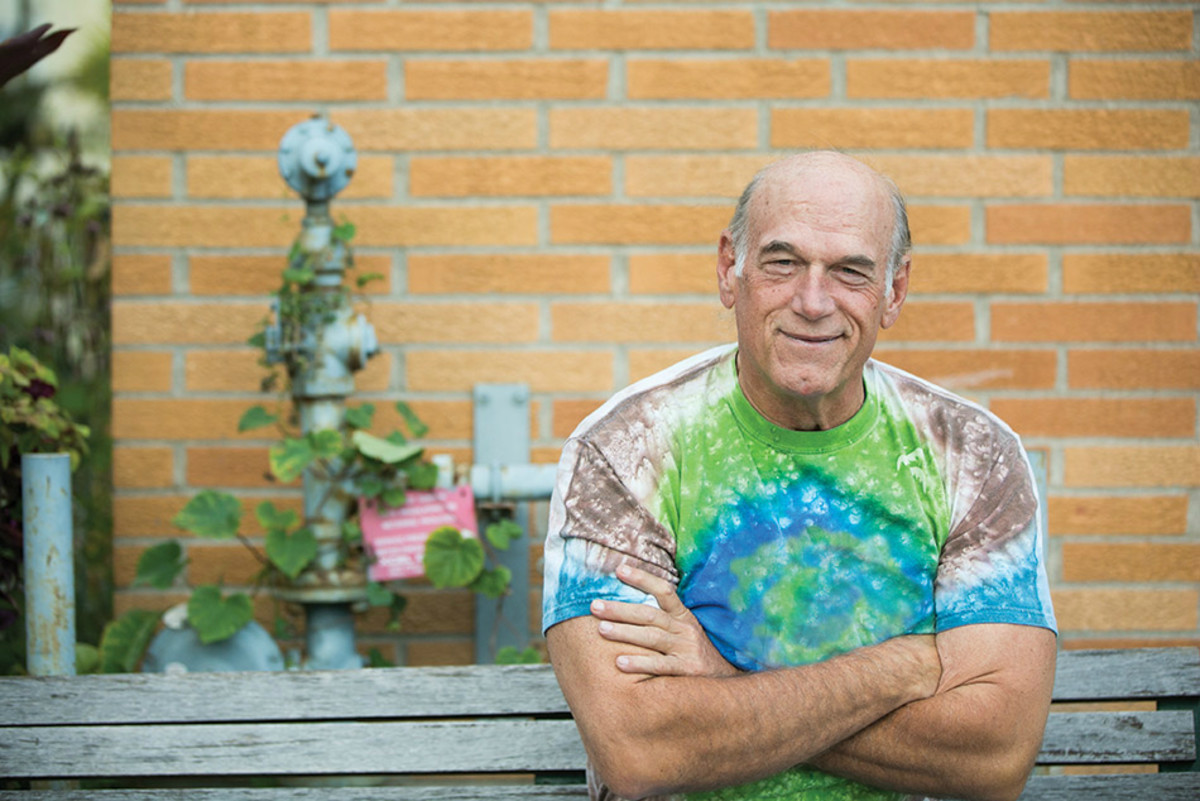
The legendary Jesse Ventura is the former governor of Minnesota, as well as a Navy SEAL, Vietnam veteran, and WWE Hall of Famer. He wrestled as Jesse “The Body” Ventura from 1975-1986, and then became the most famous WWE color commentator of all time.
Ventura is the author of Jesse Ventura’s Marijuana Manifesto, and he now shares, in his own words, the crossover between politics and wrestling.
Stay Vigilant
As many of you wrestling fans know, I was the first heel color-commentator in pro wrestling. That was Vince’s idea. Taking a villain and turning him into an announcer who rooted for the bad guy was something that had never been done before. And I had fun with it, especially when me and Gorilla were on the mic together. Where else but in front of a live audience could I have had the complete freedom to make fun of my boss!
Speaking from experience, when it comes to the elections, the mainstream media is definitely guilty of giving us heel commentary. They claim to be non-partisan. They claim to give equal coverage to each candidate under the equal-time rule, but they aren’t. And that’s one of the reasons why people are saying the system is rigged.
• From the Vault: Jesse Ventura’s radio gigs helped give him a hold on voters
Case in point: Why do you think third party candidates never get enough polling points to get into the debates? Because their policies aren’t talked about in the news nearly as much as the Democrat or Republican running for office! Think about it: you always know when Trump gives a news conference, when Clinton gives a news conference, what state and city they’re in because the media plays it live and then replays it throughout the day. But do you have any idea where Gary Johnson and Jill Stein are and what they’re telling folks at their news conferences?
Somehow breaking news only applies to Hillary and Donald. Classic heel move! Sure, the media will give Gary Johnson and Jill Stein a town hall here and a ten minute interview there to appear unbiased, but third party candidates aren’t getting mainstream coverage every single day the way Trump and Clinton are. And when they do get coverage, there’s always some talking head (aka heel) telling you “not to vote for them, even if you agree with what they have to say because they’ll never win.”
Speaking from experience, when I ran third party for mayor and then for Governor of Minnesota, the media told me “you won’t win because you’re not polling high enough,” but then when the votes were counted, it turned out I beat the Democrat and Republican without spending nearly as much money as they did. I can’t thank the people of Minnesota enough for voting their consciences instead of down traditional party lines. They picked me to be their Governor because they liked my policies. They believed I was the best choice. They didn’t care if the heel media wasn’t rooting for me (or more accurately, rooting against me).
Marijuana is another major issue the heel media chooses to ignore this election cycle, so again, don’t be fooled. Marijuana is the major issue in our country right now because it’s a whole new industry. New industry means new jobs, new tax revenue, a way to boost the economy—my latest book, Jesse Ventura’s Marijuana Manifesto, goes into the facts and figures about all that. Right now, there are nine states with a marijuana measure on the ballot and currently 25 out of 50 states have legalized marijuana in some way. On November 8th, Arizona, California, Maine, Massachusetts and Nevada will decide whether to legalize recreational marijuana for adults. Medical marijuana is on the ballot in Arkansas, Florida, Montana, and North Dakota.
States are rising up against federal law and saying enough is enough with the drug war, yet where is the news coverage on the new American revolution? Think about it: After November 8th, if those nine states vote yes to marijuana, then that means the majority of America has legalized weed and gone against federal law! And legalizing marijuana isn’t even a big risk, though the heel media would like you to believe it is.
Look at Colorado, look at Washington state. Heroin use has actually gone down in those states after recreational marijuana was legalized. For those who have access to it, marijuana is doing a lot of good for a lot of people with seizures, cancer, you name it. Plus, it’s an all-American industry—every part of the process is done right here, state-side.
The media talks about the importance of the first 100 days of the presidency. Well, if the majority of states legalize marijuana, then the president will have to address this within those first 100 days. Which is why you should vote for Gary Johnson or Jill Stein. Those are the two people who have said they’ll legalize marijuana and end the drug war.
The time has come for people to stop going to prison for using and possessing marijuana. The time has come for non-violent drug offenders to be exonerated and for their records to be expunged. And let me tell you, there were many wrestlers in my day who turned to marijuana to ease pain. There are studies that show marijuana can help athletes, such as NFL players, who have developed brain injuries from sports concussions. Of course, the media has to answer to their major advertisers like Big Pharma, so you won’t see breaking news on that research any time soon.
When it comes to politics and important issues like marijuana, I know I can’t trust the heel media to give me all the facts. They say this is an important election year—too important to throw your vote away on a third party candidate. But why would you believe a heel? And can’t a third party candidate like Gary Johnson or Jill Stein win? If enough people vote for a particular person, then that person will be president.
So take some advice from someone who knows a thing or two about politics and wrestling and the crossover between the two: It’s important to vote your conscience when it comes to picking the next president. It is also important to be a vigilant citizen. You’re not supposed to vote for the least deplorable candidate out of two major parties. You’re supposed to pick the best person for the job. Before you step into the voting booth, educate yourself so you can decide who you want to be president, who you want for your state and local reps, and where you stand on the measures on the ballot—such as marijuana. Don’t let a rigged system dictate the power of your vote.
Something to Wrestle with Conrad Thompson
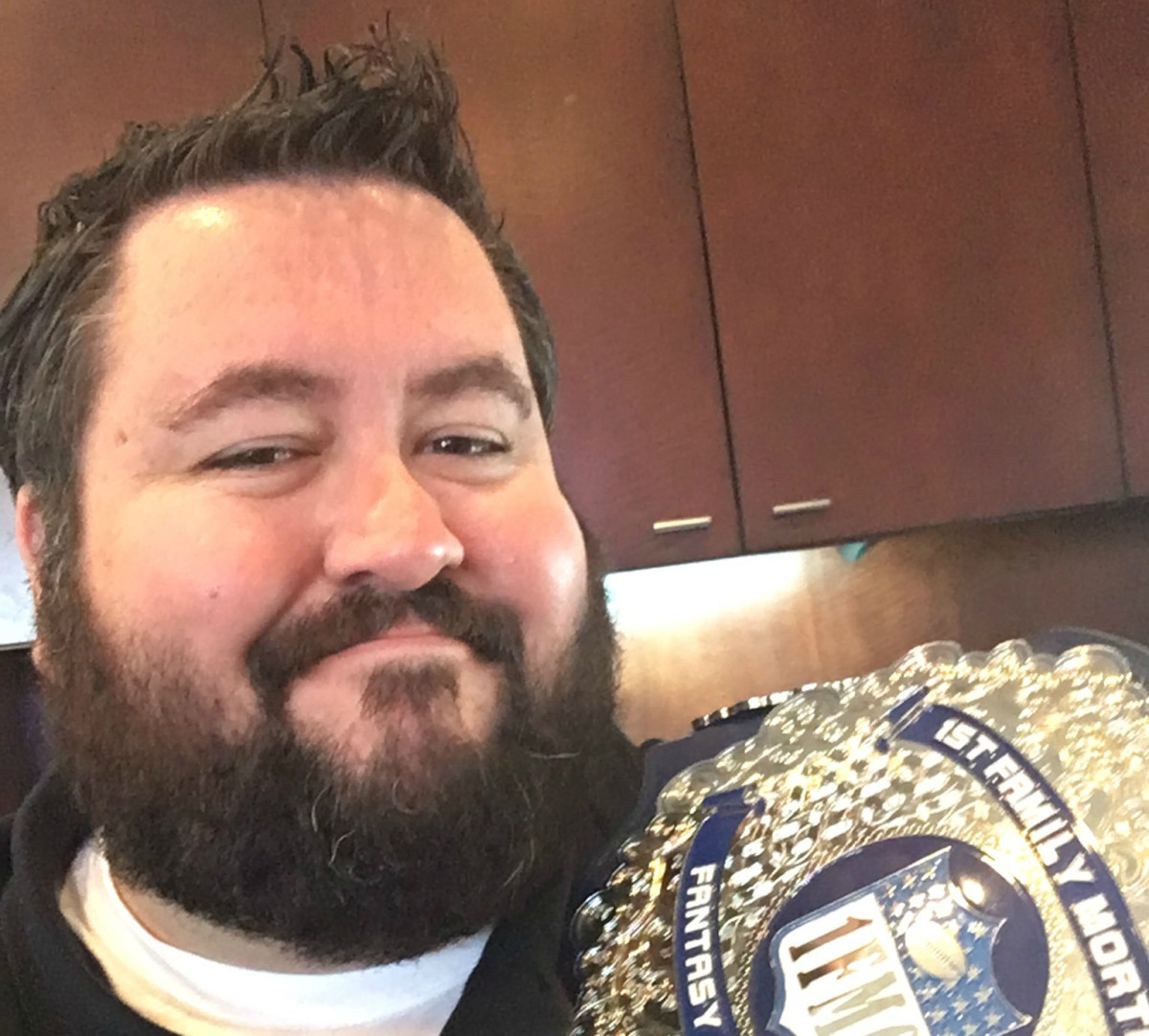
With a multitude of options, people can argue about the best wrestling podcast, but there is no other show quite like “Something to Wrestle With Bruce Prichard.”
Prichard, perhaps best known on screen as Brother Love, worked behind the scenes alongside Vince McMahon for twenty-two years in the WWE. He co-hosts the podcast with Conrad Thompson, who also co-hosts “The Ric Flair Show.”
“I’m trying to create something I would listen to and be into,” Thompson said. “Bruce trusts that I am in touch with the fan perspective online. So many fans, myself included, have been led to believe certain facts all of these years, but Bruce Prichard is telling us something totally different. And that’s what makes it such an interesting format.”
The format of the show is brilliant, as Thompson interviews Prichard about a single topic each week. The pair recently dug into Lex Luger’s failed Lex Express, where Prichard revealed that Luger preferred to leave the bus to fly to his destinations, as well as a WrestleMania VII podcast that details the entire card from someone who watched and learned as McMahon built the show.
“It’s an opportunity for fans to tune in and hear Vince McMahon’s perspective, because that’s what Bruce is offering,” said Thompson. “We review what is happening in wrestling, take some fan questions, then go into a topic and really hone in on that piece.”
The Twitter poll results are in, and Thompson will be discussing the 1990 Survivor Series with Prichard on this Friday’s podcast, which drops at noon eastern time.
Downloads of the show are increasing at a furious pace, even out-drawing TNA’s television viewership audience with some of the recent podcasts. The show is greatly enhanced by Thompson—a 35-year-old from Huntsville, Alabama—and his willingness to challenge Prichard on gimmicks, angles, and disputed finishes.
“My first introduction to wrestling was in 1988 with WrestleMania IV,” said Thompson. “I’m a fan, and I have, like a lot of the fans, grown up on shoot interviews. Over time, they’ve involved, and I’ve got to give a shout-out to Sean Oliver at Kayfabe Commentaries. His ‘Timeline’ product is amazing, and it’s the best thing that ever happened in the industry. That was the idea behind ‘Something to Wrestle With.’ We’ve tweaked that formula a little as we’ve gone, but we’re really focused on just examining one moment in time, and that’s worked for us and our audience.”
Exclusive Lucha Underground clip
The rivalry between Rey Mysterio and Chavo Guerrero meets its end with an old school stipulation that the loser has to leave the Temple forever on tonight’s Lucha Underground, which is available on iTunes, continues its third season tonight at 8 p.m. on El Rey Network.
Five Questions with… Big Damo
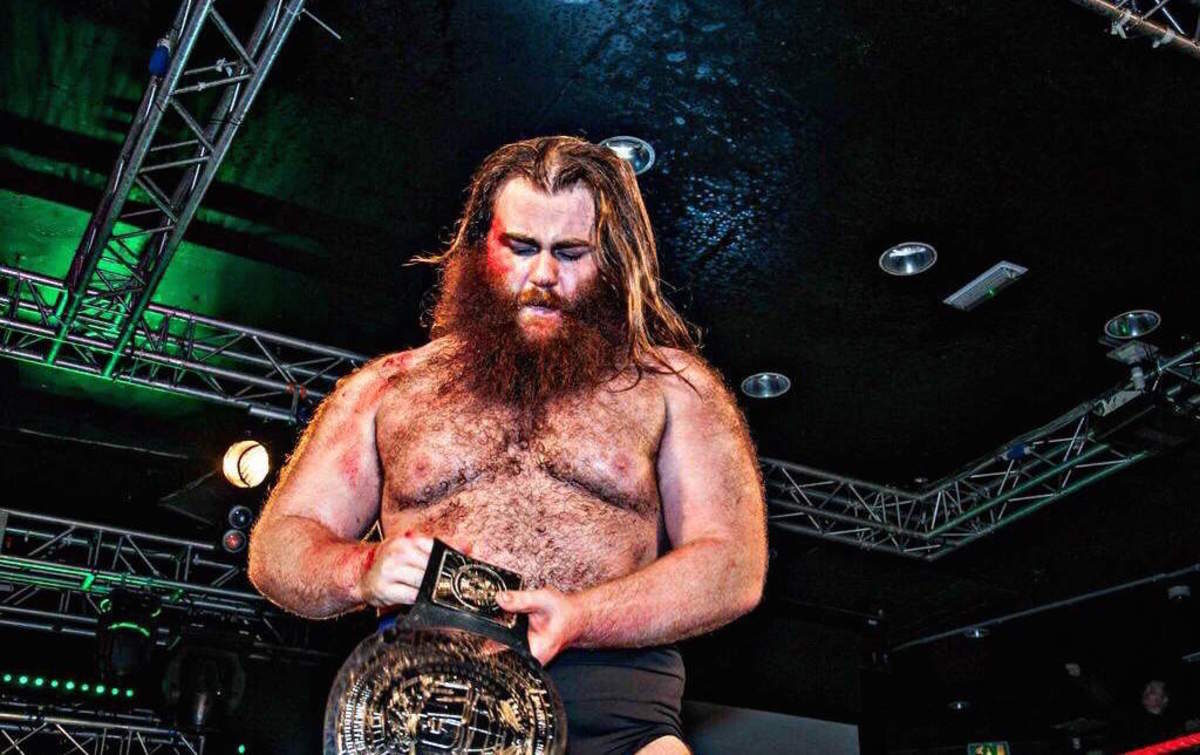
WWE announced last week its new class of nine recruits has already started training at the WWE Performance Center in Orlando, Florida. Among the signees—which included longtime Ring of Honor star Roderick Strong and former NFL player Demitrius Bronson—was Big Damo.
Damo, whose name is Damian Mackle, is from Belfast, Ireland. The 31-year-old brute is most well-known for his time with Insane Championship Wrestling in Scotland. He trained with Finn Bálor and Performance Center trainer Robbie Brookside, as well as helped train WWE Smackdown champion Becky Lynch. Before signing with WWE, he discussed his career, and future,with Sports Illustrated.
SI.com: Who is Big Damo?
Damo: I’m an explosive heavyweight. I’m a powerlifter who can fly. In layman’s terms, I’m a 330-pound guy who hits people. I’m just as likely to do a big lariat as I am a running dropkick.
I debuted in ICW, and the commentator, Billy Kirkwood, coined me the “Beast of Belfast.” That was it. Since that day, I’ve been the “Beast of Belfast”—working this image, growing my hair and the beard, and I don’t shave any more. I was wrestling for a long time and I was getting better all the time, but I tried to put myself in a promoter’s shoes and ask, ‘Why book this guy?’ I was trying to put myself in everybody’s forethoughts. Thankfully, through developing this character and this image, everything is working out.
There have been so many excellent big men over the past twenty years—go back with Vader and Bam Bam Bigelow, but now with Samoa Joe and Brock Lesnar. The mold has changed, you don’t have to be a slow, prodding guy. I’m an athletic person. I was a soccer goalkeeper and I played point guard in basketball, and I like to jump and move. I can leap, I can jump, and I have a decent bounce. So why not put it into what I do as a big man? Hopefully it’s different from whatever everyone else does. If you don’t push to find the limit, then you’re going to put a limit on yourself. So I’m going to keep pushing.
Former Bundesliga goalkeeper Tim Wiese will make his WWE debut Thursday
SI.com: Both Finn Bálor and NXT trainer Robbie Brookside were major influences in your career. How did you connect with Bálor and Brookside?
Damo: I originally trained in a company in Scotland. I moved over from Belfast to Attleborough, and I trained basically to see, ‘Can I do this?’ Then I started looking for better coaches, and when I saw Finn Bálor was taking training in Ireland, I pushed our coaches to bring him into Scotland. I even took over that school and was bringing Bálor over, and he ended up being massively influential. When I first met him, he made me realize we have to work so much harder—and treat it like martial arts. He helped, literally, change my view with that mentality.
A couple years later, I wrestled Robbie Brookside near the end of 2010. Instantly, I thought, ‘This guy has everything.’ He was a great character but he was also an excellent wrestler, and I used to travel to his school in Leicester, which is in the center of England, or we’d bring him up for two to three weeks at a time. I did two weeks solid with Robbie Brookside, and by that point I’d been wrestling five or six years, and that’s pretty much what molded my ascent. That’s when I came to the realization that I could go further and do more. Robbie Brookside was the best coach I ever had.
SI.com: How has ICW developed such an incredible following?
Damo: ICW decided to have a storyline-driven product, and it’s paid off beautifully. We were originally a small independent company, but ICW has put on a hell of a product for the past few years. We desperately tried to get on British television. The way it worked out, we got on Italian television first, and then the Fite Network. So we were in 38 countries, and still not the UK, but it was really good for all of us because it’s exposure, even the Middle East and Africa, as well as the United States and Canada. Even though ICW started as a small independent, we made it our goal to become the number one independent in the world. ICW has done a hell of a job to get to that level, and it will be very interesting to see where it goes. ICW has the comedy, the strong style, the strikes, the technical wrestling, and on top of that, it has the story.
When I started wrestling, there was no social media – and that was only twelve years ago. If it wasn’t for the internet, I wouldn’t be here. The internet has made the wrestling world so small. The independents weren’t as strong ten years or twenty years ago, and ICW is able to put their product online. So many companies are doing these on-demand subscription services, so if you like a style of wrestling, you can find it right in front of your eyes.
SI.com: How did Drew Galloway impact your career when he returned to ICW after his run in WWE in 2014?
Damo: Drew Galloway, on a personal level with me, has been the biggest influence on my career. Obviously we were sad when Drew left WWE, but we were delighted when he came to ICW. He’s helped me have a better learning experience, and he is incredible in the locker room. When he walked into the locker room, people got to see the total package. Drew can talk and he can wrestle, and he got a lot of people off their arses—the ones who were talented but weren’t working as hard as they could. Drew helped with our presentation, and the roster has evolved in the last two years since Drew came back. He’s had a really positive influence, and when ICW is trying to market their product to somebody, they can say they have a former WWE wrestler. He’s one of the most celebrated European wrestlers over the past twenty years, and made it a lot easier for ICW to market itself. I joined in the end of 2013, and the difference in the two-and-a-half years there have been astounding.
SI.com: What are you looking to accomplish next?
Damo: My goal for the last couple years has to become the number one heavyweight in Europe and become the number one heavyweight in the world. To get there can be a long process, and it will take me the rest of my career to get close. But if I don’t have that goal, then what do I have? The overriding goal is to be better today than I was yesterday, and I’m a step further today than I was yesterday.
Tweet of the Week
Cub fans STAND #CubFansUnite Words from one snake to another, @JArrieta34 & the @cubs The TIME IS NOW!! https://t.co/TOa8vyJQBN @espn @MLB
— JakeSnakeDDT (@JakeSnakeDDT) November 1, 2016
Will the Cubs drop the DDT on the Indians tonight? And don’t Jake Roberts’ promos instantly take you back in time?
Justin Barrasso can be reached at JBarrasso@gmail.com. Follow him on Twitter @JustinBarrasso.
